
Scenes/plot
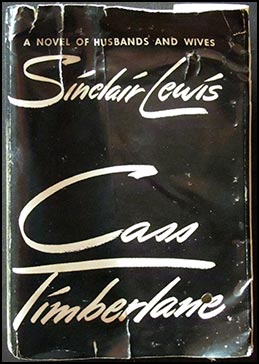
The book jacket
"Cass Timberlane" a study in Sinclair Lewis's writing process:
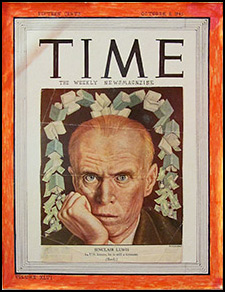
On the cover of Time Magazine when he published "Cass Timberlane." It says:
"In U.S. letters he is still a ferment."

Town map
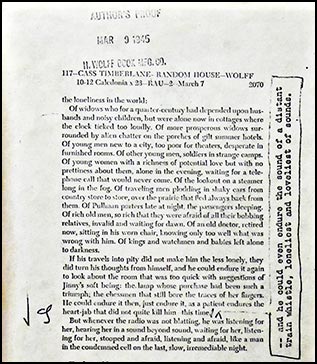
Galley proof

Names from a cemetery
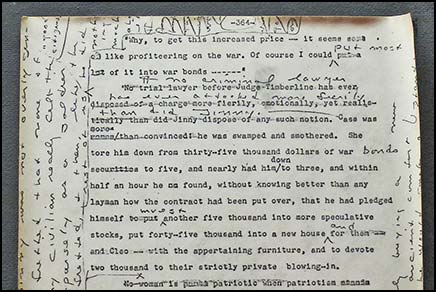
Editing

Area map
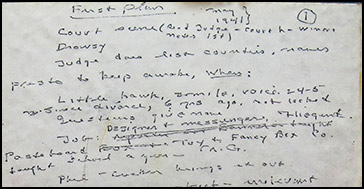
First Plan – May, 1941


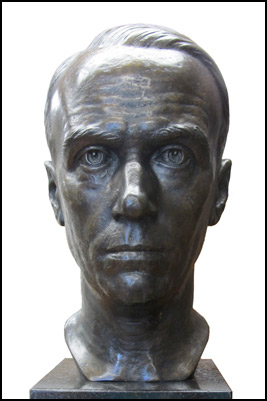
Harry Sinclair Lewis, 1885 - 1951. The first American to win the Nobel Prize in Literature.
Sinclair Lewis, Novelist
“It is impossible to discourage the real writers —
they don't give a damn what you say, they're going to write.”
Interview Movie
(Embedded version below)
MP3 or M4A Audio File
(Note: To download the podcast,
right click on the link if you are on a PC,
or control click if you are on a Mac. )
|
Location: |
Sauk Centre, MN |
|
|
Run Time: |
25:14 |
|
|
Genre: |
Novels, Plays, Short Stories |
|
|
Website: |
||
|
Raised: |
Sauk Centre, MN |
|
|
Youthful Influence: |
His step-mother, Isabel Lewis, who filled the house with books, read to him and encouraged him to read. The book The Love Affairs of a Bibliomaniac by Eugene Field. |
|
|
Favorite Authors: |
Charles Dickens, Sir Walter Scott, Jack London, Theodore Dreiser, Ernest Hemingway, Willa Cather and more. |
|
|
Creative Habit: |
With discipline, hard work and ambition: 'seat in chair' in a rented writing office. He read, studied, observed. He gathered detailed notes through his travels, and did 'psychological surveys'. He found names for characters in graveyards, and drew maps of the fictional places where his characters lived. He kept a journal, and had a backlog of plot ideas, some of which he sold to Jack London. |

The hill where Sinclair decided to write "Main Street." The hill is now in the Sauk Centre city park.

Sinclair Lewis' boyhood home

With Marcella Powers, his "intimate friend" in the late '30s and early '40s

Sauk Centre's Main Street
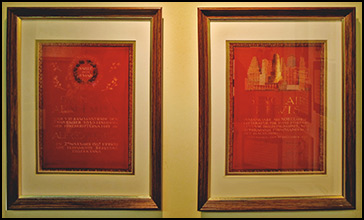
America's first Nobel Prize in Literature, Sinclair Lewis 1930
Books
Hike and the Aeroplane (1912, as Tom Graham)
Our Mr. Wrenn: The Romantic Adventures of a Gentle Man (1914)
The Trail of the Hawk: A Comedy of the Seriousness of Life (1915)
The Job: An American Novel (1917)
The Innocents: A Story for Lovers (1917)
Hobohemia (1919)(play)
Free Air (1919)*
Main Street (1920)*
Babbit (1922)*
Arrowsmith (1925)*
Mantrap, a Story of the Northern Wilds *(1926)
Elmer Gantry (1927)*
The Man Who Knew Coolidge (1928)
Dodsworth (1929)*
Ann Vickers (1933)*
Work of Art (1934)
It Can't Happen Here (1935); (play 1936)*
Jayhawker (1935) (play)
The Prodigal Parents (1938)
Bethel Merriday: A Story of a Young Girl on the Stage (1940)
Gideon Planish (1943)
This is the Life (1944) (play)*
Cass Timberlane (1945)*
Kingsblood Royal (1947)
The God-Seeker (1949)
World So Wide (1951, posthumously)
If I Were Boss: The Early Business Stories of Sinclair Lewis (1997)
Minnesota Diary, 1942-1946 (2000)
Go East Young Man: Sinclair Lewis on Class in America (2005)
* Made into films and/or TV programs, as were his short stories "Little Bear Bongo," "Ghost Patrol," "Let's Play King", "A Letter from the Queen," "The Unpainted Woman," "Nature Incorporated," "The Good Sport"
Awards
Pulitzer Prize - Arrowsmith (1926), which he refused. **
Nobel Prize in Literature (1930)
Prometheus Hall of Fame Award - It Can't Happen Here (2007)
** Lewis's Main Street and Babbit were chosen for the 1921 and 1923 Pulitzers, but the committee was overruled by the trustees in both instances. The prizes in those years instead went to Edith Wharton for The Age of Innocence and Willa Cather for One of Ours, respectively.
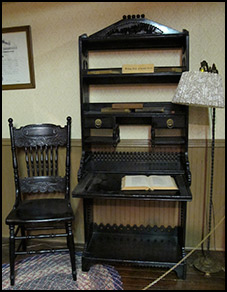
Sinclair's Desk

Dave Simpkins

Jo Glinnon
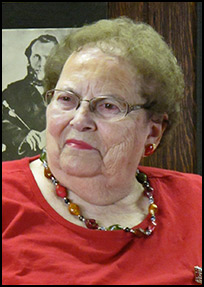
Joyce Lyng
Chosen for a Pulitzer Prize for Arrowsmith, he declined the award. A few years later he was awarded the Nobel Prize for Literature, becoming the first American to win this highly coveted honor.
We were very pleased when three of the leaders of the Sinclair Lewis Interpretive Center and Museum in Sauk Centre, Minnesota agreed to share with us, and you, their stories about this significant American writer whose themes and insights ring as true and biting today as they did almost a century earlier.
If the hallmark of a great writer is his or her ability to see, analyze and depict the hidden reality beneath the world around them, then Sinclair Lewis is certainly one of our nation’s great writers.
He was born in a small Scandinavian immigrant town in the northern prairies of Minnesota. His father was the local doctor, and although his mother died of tuberculosis when he was only six, his step-mother proved to be a major influence in his life of letters. An avid reader, Lewis knew that writing was to be his life early on. In high school he began writing for the local newspaper, and one of the people in this interview was the editor of that same publication nearly a century later.
While a student at Yale he met and became friends with Jack London. As described in this interview, as well as our earlier interview on London, Lewis was asked by the very successful adventure novelist to submit plot ideas for pay. One of those Lewis sent became the basis to a Jack London novel published years after his death. During this time he also became acquainted with Upton Sinclair and was a janitor at his short-lived utopian community, Helican Hall.
One of Lewis's earliest novels, Main Street, became one of America’s first major best sellers, and quickly made Lewis a wealthy and respected writer. He followed this insightful look at small town life with a series of equally poignant studies. Among these were Babbitt, Arrowsmith, Elmer Gantry, and the fascinating and satirical idea of fascism coming to America, It Can’t Happen Here. Many of his works were adapted for films, including a Disney animated movie.



